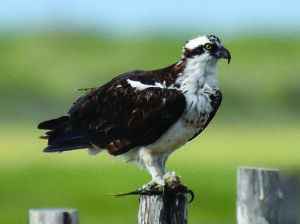(Editor’s note: Suzette Stitely is a member of the Talbot Bird Club and travels extensively for birdwatching.)

Ospreys are the only raptor that plunge-dive to feed. They will hover until spotting fish and using their excellent vision dive feet-first to catch fish near the surface with amazing accuracy. (Photo by Suzette Stitely)
Spring is here and that means the return of the Mid-Shore’s iconic bird — the osprey.
Every year around St. Patrick’s Day, Osprey make their return from South America to once again fill our skies with their rhythmic ascending and descending, “cheep, cheep, cheep, cheep, cheep, cheep, cheep” calls.
Ospreys have rich dark-brown upper parts with white underparts and a white head with a wide, brown eye stripe.
You can see ospreys with a quick stop near water anywhere on the Mid-Shore.
Osprey are commonly seen sitting on their huge stick nests which they build on trees, platforms in the water, or on large highway signs along Route 50.
Ospreys have adjusted to using many human structures to build their nests, so long as it’s safe and near water.
On the Chesapeake Bay, ospreys have almost entirely shifted nest location from trees to man-made structures.
Ospreys are usually monogamous and mate for life.
The male chooses the site and may start to build the nest.
He’ll carry the bulk of the sticks to the nest where the female arranges them to her liking.
Once the nest is built, an average of three eggs is laid and they are incubated mostly by the female.
Once hatched, the young are fed small pieces of fish and need 50-55 days before they are ready to leave the nest.
Studies are showing that birds on the Chesapeake Bay now need longer to fledge; possibly linked to a shortage of food.
In fact, the decrease in the Menhaden population due to over fishing is leading to decreased survival of osprey young on the Chesapeake Bay.
Ospreys are the only raptor that plunge-dive to feed. They will hover until spotting fish and using their excellent vision dive feet-first to catch fish near the surface with amazing accuracy.
Powerful wing strokes are then needed to take off after catching the fish while partially submerged in water with the heavy load — a large fish can increase the weight the osprey needs to lift by 50 percent.
Once in the air, the fish is maneuvered in the osprey’s feet (using their reversible outer toe) to be aimed head forward to reduce drag.
Fish are usually eaten on a perch near the nest.
Learn more about birds, including ospreys, by joining the Talbot Bird Club.
The Talbot Bird Club offers local birding trips weekly and welcomes anyone who has an interest in birds, whether a novice or experienced ornithologist, and whether you enjoy watching birds at your feeder or traveling throughout the world.
Our members learn from one another and are willing to share their knowledge.
The Talbot Bird Club is part of the Maryland Ornithological Society and also has a Facebook page.



